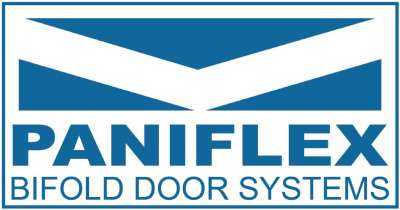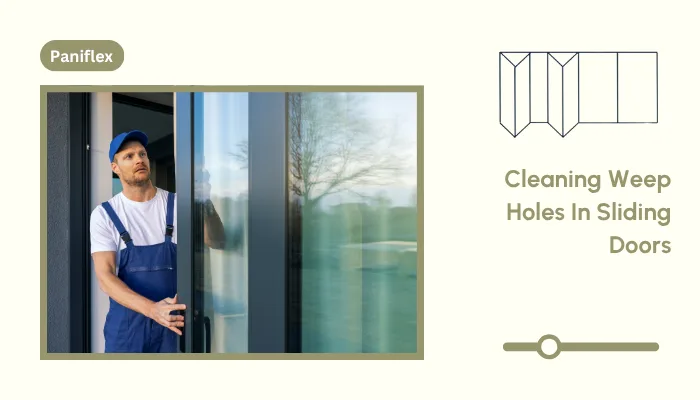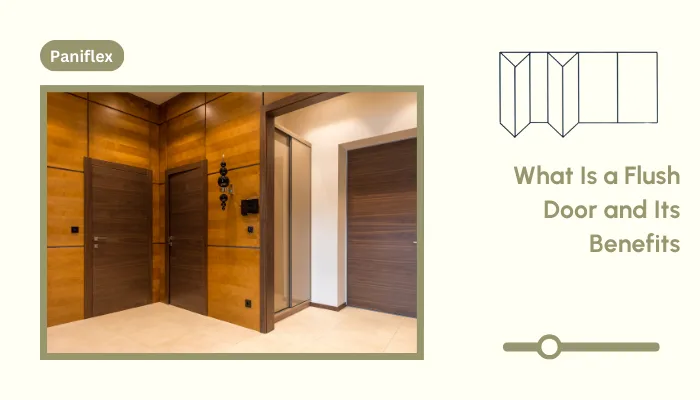Weep holes are a small but critical part of sliding door systems. Designed to let water drain away from the tracks, they help prevent pooling, swelling, and long-term damage to door frames. Over time, however, dirt, debris, and even insects can clog these openings, leading to leaks and operational issues.
We understand how easy it is to overlook these minor details until water starts backing up and causing more significant problems. This guide will walk you through why weep holes matter, how to clean them properly, and tips to keep them clear for the long haul.
Ready to experience the benefits of custom closet doors? Explore our range of Paniflex products now.
TL;DR
- Weep holes allow sliding doors to drain water properly, preventing damage to frames and tracks.
- Clogged weep holes cause pooling, sticking doors, and water intrusion if left unaddressed.
- Regular cleaning with proper tools keeps the drainage system functional and extends the door’s lifespan.
- Seasonal maintenance and inspections help prevent future clogs and costly repairs.
What Are Weep Holes?
Weep holes are small, strategically placed openings at the bottom of sliding door frames. Their purpose is to let water drain out of the door tracks, preventing it from pooling and damaging the door system. These holes may look insignificant, but they play a vital role in maintaining both the functionality and longevity of sliding doors.
Weep holes serve several purposes, such as:
- Prevents Water Damage: Allows rainwater and condensation to escape, rather than collecting in the door track, thereby protecting the frame from rot or corrosion.
- Stops Mold and Mildew Growth: Keeps the door threshold dry, reducing the risk of mold developing in damp areas.
- Ensures Smooth Door Operation: Prevents standing water from swelling wooden frames or freezing in colder climates, which can cause the door to stick or jam.
- Protects Indoor Flooring: Reduces the chance of water leaking indoors and damaging flooring near the door.
Though small, weep holes act as a drainage system that protects sliding doors from common moisture-related issues. Keeping them clear is essential to the health of the door assembly.
When weep holes become clogged, their protective function fails, often leading to noticeable signs of trouble. Let’s examine how to determine when these drainage channels require cleaning in the next section.
Suggested Watch: Watch this video to learn more about cleaning weep holes.
Signs That Weep Holes Need Cleaning
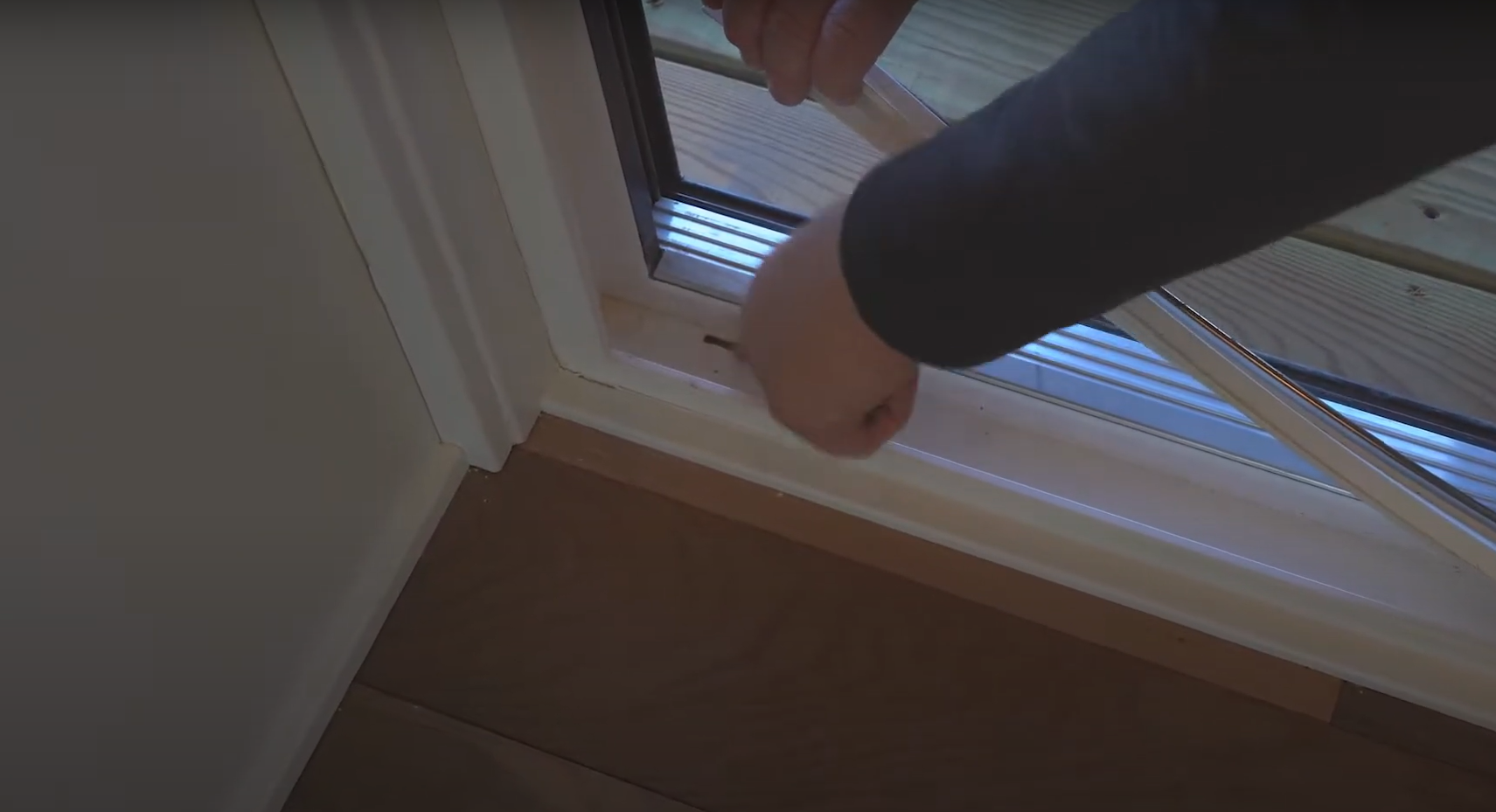
Clogged weep holes are not always obvious until problems begin to surface. Regular inspections help identify issues early and prevent costly damage to the door system and surrounding structure. Watch for these warning signs that signal a need for cleaning.
1. Water Pooling in Door Tracks
If water lingers in the sliding door track after rain, it likely means the drainage path is blocked. Left unchecked, this standing water can lead to corrosion or frame warping.
2. Sticking or Hard-to-Slide Doors
Swollen frames or debris buildup from trapped moisture can cause sliding doors to drag or jam. This is a common symptom of poor drainage.
3. Visible Debris or Insect Activity
Mud, leaves, or insect nests near the weep holes are clear indicators of a blockage. Even small obstructions can prevent water from escaping effectively.
4. Water Leaks or Stains Indoors
Moisture marks on flooring or walls near the door may result from water backing up and finding alternate paths inside the building.
Identifying these signs early helps avoid more serious water damage or the need for expensive repairs. Cleaning the weep holes promptly restores their function and protects the door system.
Once you have confirmed that the weep holes are clogged, the next step is to gather the right tools and materials for safe and effective cleaning.
Suggested Read: Installing Sliding Closet Doors Over Carpet
Tools and Materials Needed for Cleaning
Cleaning weep holes does not require specialized equipment, but using the right tools ensures the job is done thoroughly without damaging the door frame or drainage system.
Below is a list of recommended tools and their purposes.
| Tool/Material | Purpose |
|---|---|
| Soft brush or toothbrush | To loosen surface debris around weep holes safely. |
| Compressed air canister | To blow out dust, dirt, and small obstructions. |
| Vacuum with hose attachment | To remove loosened debris and prevent re-entry. |
| Pipe cleaners or flexible rods | To gently dislodge stubborn blockages inside holes. |
| Mild detergent and water | To clean grime or algae buildup in and around holes. |
| Safety gloves and eyewear | To protect hands and eyes from debris or splashes. |
Having these tools ready simplifies the cleaning process and reduces the risk of unintentionally damaging the sliding door assembly.
With the tools in hand, you can proceed to the actual cleaning process. The following step-by-step guide ensures your weep holes are cleared properly and function as intended.
Step-by-Step Guide to Cleaning Weep Holes
A systematic cleaning approach ensures that debris is fully cleared and drainage is restored without damaging the door system. Follow these steps carefully to maintain the integrity of the weep holes.
1. Inspect and Locate the Weep Holes
Start by identifying all weep holes along the sliding door frame. Check both the interior and exterior sides.
- Examine the door threshold for small slits or round openings.
- Look for any obvious obstructions like dirt, insects, or sealant.
- Ensure that drainage paths are visible and accessible for cleaning.
2. Clear Loose Debris
Before addressing stubborn blockages, remove surface debris from the door tracks and holes.
- Use a soft brush or toothbrush to sweep away loose dirt around the openings.
- Apply compressed air to blow out dust or small particles.
- Vacuum up debris to prevent it from re-entering the weep holes.
3. Flush with a Mild Detergent Solution
This step helps dislodge grime and organic buildup inside the drainage path.
- Mix a mild detergent with warm water.
- Gently pour or spray it into the weep holes and observe the drainage.
- Allow the solution to sit briefly if needed for stubborn grime.
4. Use Flexible Tools for Stubborn Blockages
If water is still not draining properly, carefully use flexible tools to clear internal clogs.
- Insert a pipe cleaner or flexible rod into the weep hole with light pressure.
- Rotate or move the tool gently to avoid damaging the frame.
- Repeat flushing and testing until water flows freely.
5. Test Drainage Functionality
After cleaning, verify that the weep holes are clear and effective.
- Pour a small amount of water into the door track.
- Check that it flows out through the exterior weep holes without backup.
- Repeat cleaning steps if the drainage is still slow or blocked.
This careful, step-by-step process not only restores proper drainage but also protects the sliding door system from unnecessary wear or water-related damage.
While the cleaning process is straightforward, some situations present additional challenges. Let us look at common obstacles you may encounter and how to overcome them effectively.
From the Community: Read this thread if water gets trapped in the sliding door track.
Common Challenges While Cleaning Weep Holes
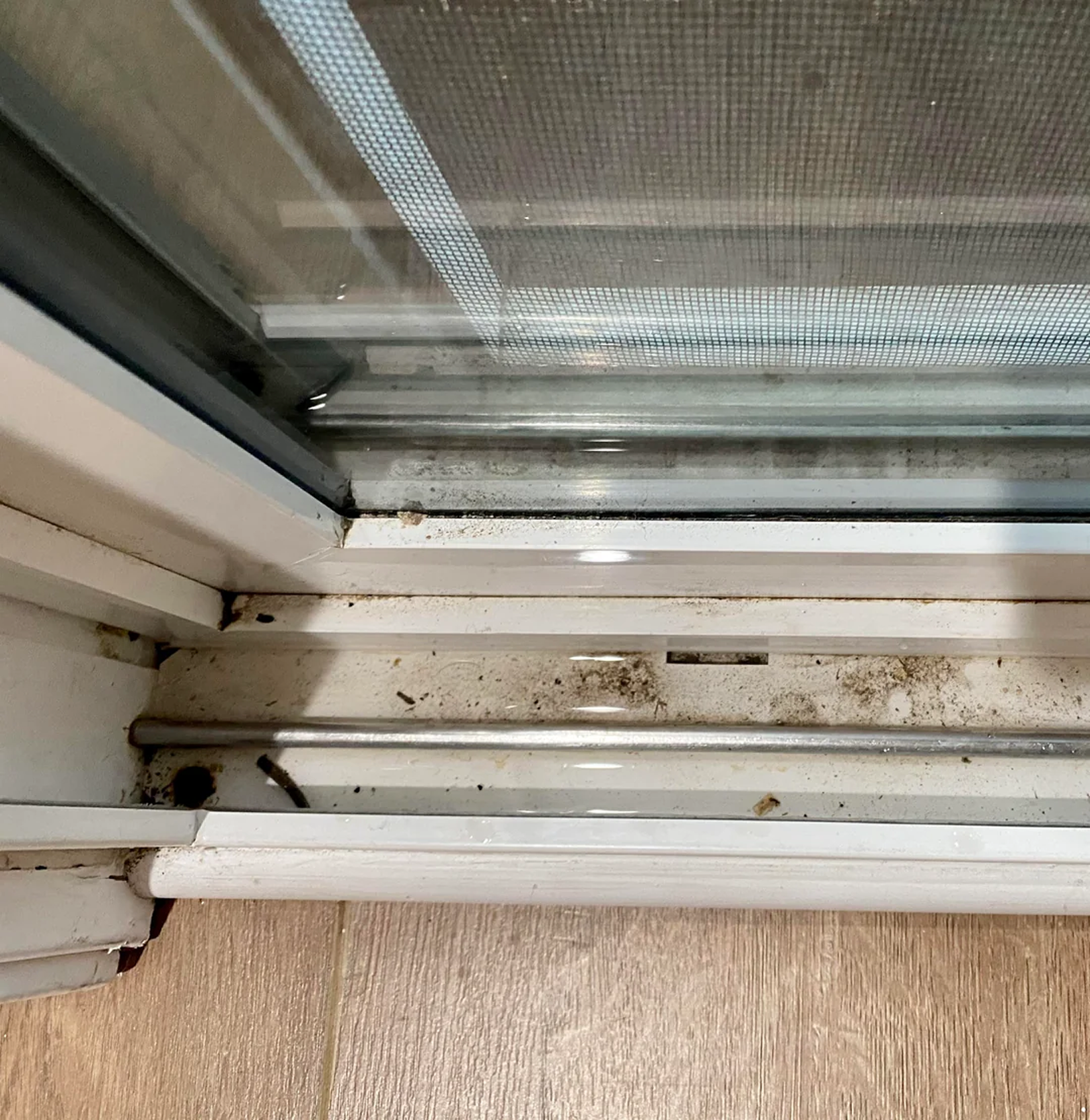
Even with the right tools and method, cleaning weep holes is not always straightforward. Certain issues may require extra care or alternative approaches to prevent damage to the door system.
1. Blockages That Resist Flushing
Stubborn debris or hardened dirt may not respond to water or air alone. Use a flexible rod to loosen the material without enlarging or damaging the hole gently. Avoid sharp objects that could harm the drainage channel.
2. Hidden or Painted-Over Weep Holes
On older doors, weep holes may be concealed under paint or caulking. Carefully clear the paint with a utility knife tip or small pick, taking care not to scratch the frame or widen the opening beyond the design specifications.
3. Water Still Pooling After Cleaning
If water continues to back up, the issue might be a misaligned frame or clogged sub-sill drainage. Inspect for warping or structural problems and recommend professional servicing if adjustments beyond cleaning are needed.
Recognizing and addressing these challenges early helps maintain proper drainage and protects the door system from further complications.
Once the weep holes are clear, keeping them that way is key. Here are some pro tips for preventing future clogs and ensuring long-term performance.
Suggested Read: DIY Ideas for Replacing HVAC and AC Closet Doors
Pro Tips for Preventing Future Clogs
Keeping weep holes clear is easier with a few simple maintenance practices. These proactive measures help prevent debris buildup and ensure proper drainage year-round.
- Vacuum Door Tracks Regularly: Clean tracks with a vacuum to stop dirt and leaves from reaching the weep holes.
- Inspect After Heavy Weather: Check for blockages following storms, as wind-driven rain often deposits debris in tracks.
- Use Screen Inserts or Guards: Install protective screens where feasible to minimize the entry of insects and particles into the drainage system.
- Avoid Over-Watering Nearby Plants: Excess moisture and runoff from landscaping can overwhelm drainage and carry soil into weep holes.
- Schedule Seasonal Maintenance: Add weep hole inspection to regular door maintenance routines, especially before rainy seasons.
For contractors, interior designers, and architects, incorporating these practices into your maintenance recommendations adds value for clients and reinforces your reputation for delivering lasting solutions. Let’s explore why regular attention makes such a significant difference.
Suggested Read: How to Install Sliding Closet Door Floor Guides on Various Surfaces
Importance of Clean Weep Holes for Door Longevity
Weep holes are a small detail with a significant role in preserving your sliding door system. When neglected, clogged drainage leads to moisture damage, structural problems, and costly repairs that shorten a door’s lifespan.
- Prevents Frame Corrosion and Rot: Clear drainage protects aluminum, wood, and composite frames from water-related deterioration.
- Maintains Smooth Operation: Prevents swelling, track damage, and sticking issues caused by trapped water.
- Protects Adjacent Surfaces: Reduces water intrusion that can damage flooring, thresholds, and interior finishes near the door.
- Supports Manufacturer Warranties: Regular cleaning helps maintain compliance with care requirements outlined in door warranties.
Clean weep holes are essential to preserving both the function and appearance of sliding doors over time. This small maintenance task has outsized benefits for performance and durability. A clear, well-maintained drainage system ensures sliding doors perform at their best for years.
Ready to experience the benefits of custom closet doors? Explore our range of Paniflex products now.
Conclusion
Weep holes may seem like a minor feature, but their role in protecting sliding doors from moisture damage and operational issues is critical. Regular inspection and cleaning ensure proper drainage, extend the life of the door system, and prevent costly repairs. For contractors and professionals, including this maintenance in routine checks helps avoid callbacks and builds long-term client trust.
At Custom Door & Mirror, our sliding doors are designed with precision-engineered drainage systems that support smooth performance in demanding environments. Our doors are fabricated to minimize clogging issues and make maintenance easier for end users.
Explore our range of custom sliding doors or contact our team for solutions built to your exact specifications.
Frequently Asked Questions
- How to clean weep holes on a sliding door?
Use a soft brush to clear surface debris, followed by the use of compressed air or a vacuum. Flush with mild detergent and water, then gently insert a flexible rod to dislodge blockages. Test the drainage with water.
- How do you clean out weep holes?
Locate the weep holes along the frame. Brush away dirt, use compressed air, and flush with water. For stubborn clogs, use a pipe cleaner or flexible rod carefully. Avoid using sharp tools to prevent damage to the drainage system.
- Is there a way to clean inside a double-pane sliding glass door?
No. Double-pane glass is sealed, and cleaning inside requires professional service if moisture or debris is present. Regularly cleaning external tracks and weep holes prevents water from seeping into the frame and affecting the glass unit.
- How often should weep holes be cleaned?
Inspect and clean weep holes at least twice a year, preferably before and after rainy seasons. In high-debris areas or after storms, check more frequently to ensure proper drainage and prevent water-related damage.
